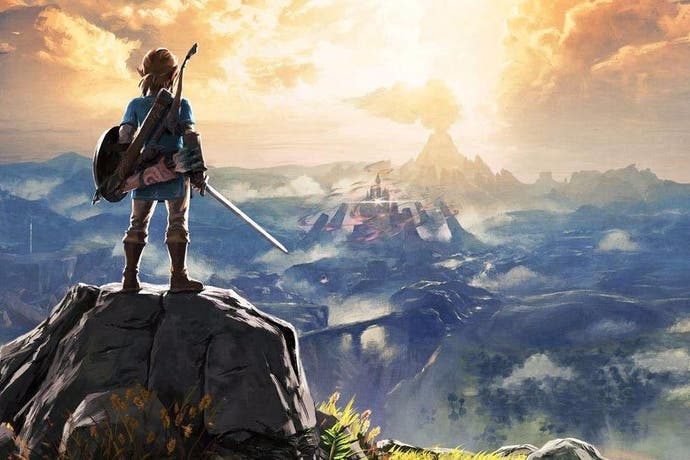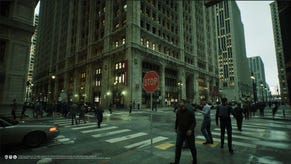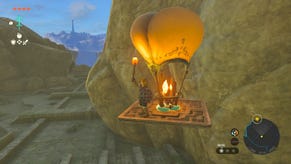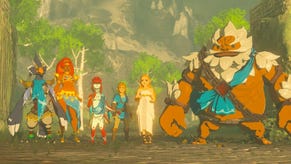Breath of the Wild shows Nintendo is learning from PC games
The ultimate overworld.
I want to tell you about the moment I figured out what sort of game Breath of the Wild was. There have been many moments like it since, and everybody who plays it will have dozens of their own. But this one was mine.
I'd gone defiantly off-piste in the game's starting plateau, ignoring the critical path in favour of a free-roaming Bokoblin hunt. Ahead of me, in a skull-shaped cave, gawky monsters too tough to fight huddled around bright red barrels of gunpowder. I've played computer games; I know how this works. I found a rock to squat on and practice my aim. It took three or four arrows before I found that if I pointed my bow up at the skull's eye socket I could arc a projectile square through the mouth of the cave and into one of the barrels and - nothing.
There was a distant thunk. Startled Bokoblin explored their surroundings. Their sentry looked alarmed.
Nothing exploded.
Unprompted by the game, I considered this new information: impact alone wasn't enough. I needed to get fire from over here to over there.
I opened my inventory and moved a stack of wood into my hands before placing it in front of my rock. Then I ran back to a Bokoblin camp that I'd cleared earlier and shoved a branch into their campfire. I ran back, set my own pile of logs alight, a drew my bow. Inching closer and closer to the flame, I hoped that Breath of the Wild would respect my logic. It did: the arrow lit up. I aimed at the skull's eye socket and, like Bron at the Blackwater, let it fly. The explosion shook the cave and as those Bokoblin died I realised: Nintendo has made a 'and then the grenade rolled down the hill' game.
'And then the grenade rolled down the hill' was a running joke on the wonderful Idle Thumbs podcast for many years, shorthand for any gaming anecdote where a bit of simple simulation - usually physics, usually in Far Cry 2 - was enough to prompt hours of rapturous consideration of the promise of emergent game design. The other word we use for these games is 'immersive sims', but it's not the 90s so let's loosen up a little, granddad.

That said, this moment was enough to make me - somebody who associates this kind of simulation closely with the history of PC games - realise that Nintendo had entered, and demonstrated mastery of, a school of design that I'd never have included them in. Breath of the Wild is humbling and revelatory in that regard. From its cooking system to its physics to the experimentation it encourages to the secrets lurking in its farthest reaches, this is a masterpiece of immersive sim (oh, go on then) execution.
I'd argue that it's more notable in this regard than it is as an open world game, which is the comparison that it has more frequently drawn. It has towers to climb, a large world to explore, and lots of things to do - but what it communicates with each of these is very different to what we've come to think of when we see the phrase 'open world'.
Consider the competition. Assassin's Creed's vantage points are binary switches that, when toggled, light up activity nodes in a section of the map. Across the span of open worlds in which they (or something like them) feature, they play a role in training players to break down a large game world into a to-do list of often heavily templated tasks. In turn, this allows developers to create full-feeling open worlds relatively quickly, without spending too much time contending with inefficient and fiddly matters of game design. They're a perfect fit for studios rich with production bandwidth but short on time. The measure of success for a Ubisoft open world is how long it takes for the premise to wear thin enough that you can see the project management software beneath.
Breath of the Wild is different. It has towers, sure, but the experience of finding them, climbing them, and deriving your next direction from them is analogue and, like everything else in the game, puts the player's imagination and agency first. Shrines, lit up in orange, are the game's clearest example of Stuff To Do. You're quickly taught how to find them, and how to assign waypoints to them. Yet it's worth dwelling on the difference between this and its Ubiworld equivalent. Ezio squats on a church steeple, the camera pans, an eagle cries and - lo - the content is beheld. In Breath of the Wild, you look and you assign priority to the things you see. That might be a shrine, it might be a town, it might be a mysterious statue, or it might be something much grander still. Nintendo is confident enough in the depth and variety of the world that it has created that it doesn't need to reassure you that there's something to do wherever you go. There just is.
Oli made the comparison to Skyrim in his review and this is warranted. Indeed, Breath of the Wild represents the fulfillment of the hoariest of old Todd Howard cliches: see that Death Mountain? You can go there. The Elder Scrolls connection goes much deeper than that, however, past Skyrim and Oblivion to Morrowind. Morrowind had an interest in systems and simulation that was subsequently eroded by its successors. It was a game about tinkering with magic reagents to create bizarre custom spells and magic items, something reflected in Breath of the Wild's joyous sense of experimentation. The moment early in Morrowind where you retrieve a scroll detailing an over-tuned jumping spell from the body of a falling mage is pure Zelda - down to the slapstick punchline if you choose to use it.
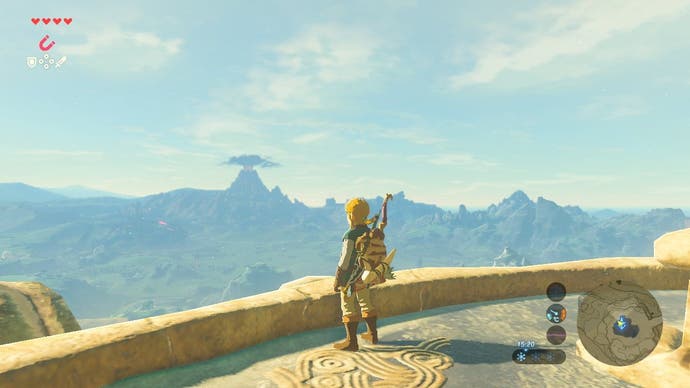
Breath of the Wild isn't like The Elder Scrolls because it's big, then, or because it's got swords and goblins in it, but because of a shared attitude towards the player - and the absence of this attitude in most modern open world games is what pushes it away from them. However, this enthusiasm for systems-driven fantasy did not originate with Morrowind. Nor did it originate with Daggerfall, Morrowind's predecessor, or with The Elder Scrolls series at all. We're in Dungeons & Dragons territory, here, and the urge to recreate the conditions of Gary Gygax's basement in digital form is arguably the most important animating force in PC game design of the 80s and 90s.
That effort saw one of its first great successes, and PC gaming as a whole found one of its founding texts, in Ultima Underworld. Paul Neurath's rudimentary first-person dungeon simulator aspired to be a fantasy adventure that was more than icons on a grid. It sought to expand the player's verb-set beyond 'fight' and 'move', to incorporate rudimentary physics - even a variety of applications for fire, which links it directly to one of Breath of the Wild's key themes. To the extent that Breath of the Wild can be considered part of the history of PC game design, then, it is because you can draw a direct line from Ultima Underworld to this.
Although the early Elder Scrolls games are indebted to Ultima Underworld, its influence is much broader than that. As a first person game that was interested in being more than a monster maze, it also provided the bedrock for what would subsequently be thought of as the immersive sim. System Shock and Thief both owe a great deal to Underworld, as does Deus Ex and, latterly, Bioshock and Dishonored. Far Cry 2 belongs in that pantheon, too, and although it is the game that Breath of the Wild most reminds me of it is that attitude again, that enthusiasm for freeform play that binds all of these games together across their disparate genres.
For all that these games have in common with Breath of the Wild, two things stand out as differences. The first is that Breath of the Wild basically works, and has been executed with a degree of polish that reassures you that it isn't about to implode. That might sound a little glib, but it's a key point of divergence from Ultima Underworld and its legacy. Many of the most beloved PC games of all time stared up at their gorgeous dreams from the buggy and crash-prone gutter. There's something romantic about their recurring tragic unfinished-ness, but the romance wears off. Nintendo enters this space as the straight-edge artist that you resent at first but whose stability and consistency is needed. The immersive sim, gaming's White Album, had been getting by on a string of John Lennons and George Harrisons. It needed a Paul McCartney.

The second major difference, and perhaps the most obvious, is the type of story that Breath of the Wild tells and how it tells it. From System Shock to Far Cry 2 and Skyrim, simulation has traditionally been employed in service of a serious, detailed narrative. Although these games are often platforms for strong writing, this has always created a disconnect to one degree or another. The freedom that Dishonored affords its player allows it to act as an intelligent fable about abuse of power: but it also means that it is sometimes a game about eating a lot of eels, and sometimes a game about seeing if you can topple a tyrant by throwing a dog at him. Its strengths can create weaknesses in that regard.
By contrast Breath of the Wild is a fairytale and happy to be one. It has a huge, evocative world, a sense of humour, and a plot that fits on a page. Nintendo abdicates the narrative aspect of the immersive sim's traditional vaunting ambition, but this feels a little like wisdom. A lighter tone suits the immersive sim, whose best moments have always traditionally revolved around something falling off something else. There's a degree to which these developers have always been trying to write a Neal Stephenson novel using only Tom and Jerry's vocabulary - of course it would be clear-thinking Nintendo that eventually came along and just made a cartoon instead.
Breath of the Wild doesn't solve all of the immersive sim's problems: the difficult matter of narrative is still worth tackling, and the attempt is still yielding fruit in the form of games like Firewatch and Gone Home. But what it does do, and what I find most heartening about it, is highlight everything that is wonderful about a game where a grenade can roll down a hill, or where a homemade fire arrow can imbue the player with a phenomenal sense of achievement while encouraging further playfulness.
In entering this design space Nintendo has made a resonant statement about their values as designers, and done much to ensure that these values get passed on to a new generation of players and hopefully a new generation of game creators too. It seems obvious in hindsight, but a kid-friendly, staggeringly well-executed immersive sim is about the best thing that could have happened to the mainstream game industry in 2017. It's one thing to think about how Breath of the Wild fits into the history of this ambitious form of play: it'll be something else to watch it make that history in the years to come.
